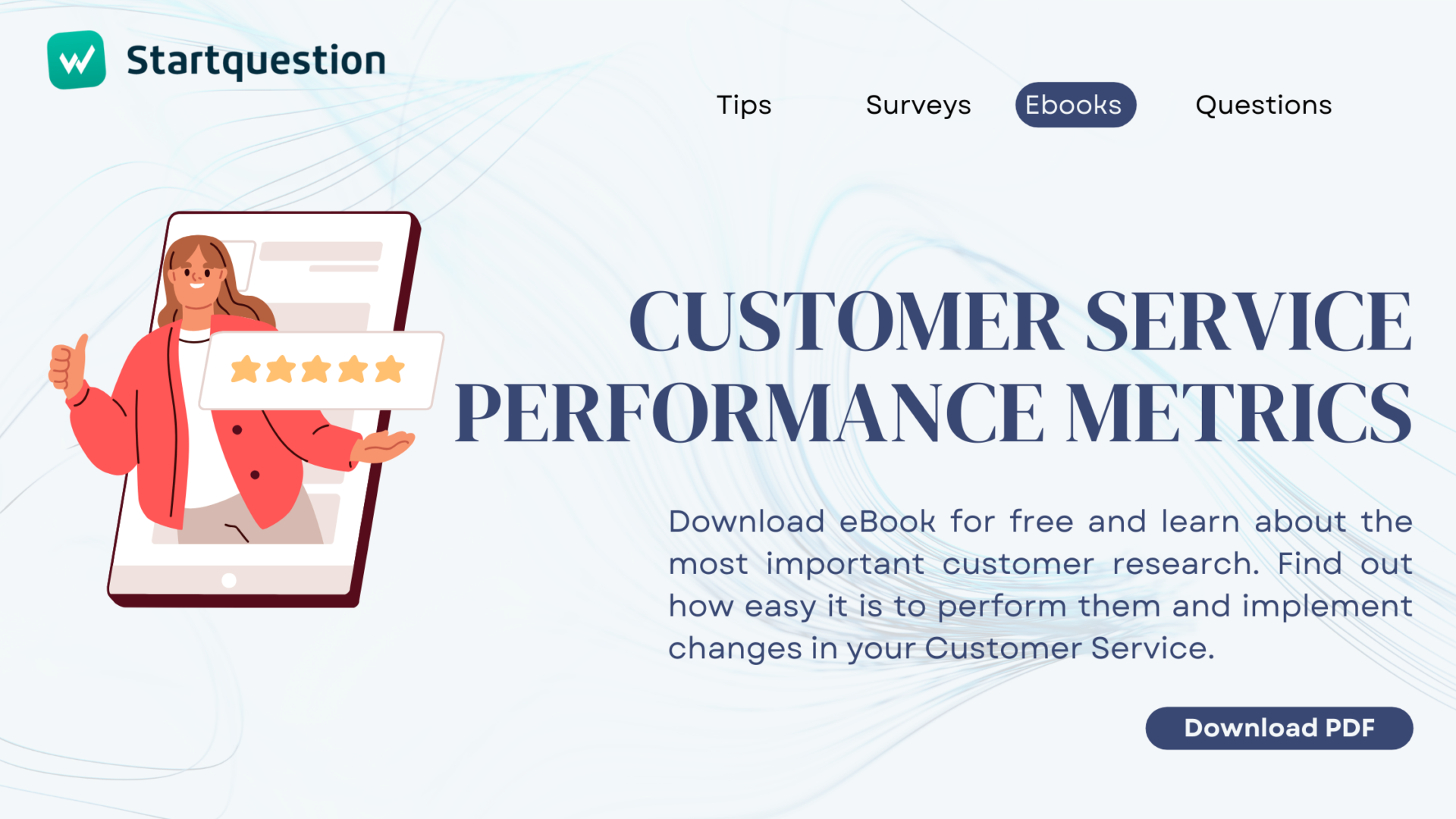Employees are a key resource for each employer. But how often Your company performs among them satisfaction surveys — Employee NPS (eNPS)? Once a year? Once every few years? And maybe in times of crisis? It’s a big mistake.
Most employers no longer need to prove the value of internal communication.
Management understands that skepticism among employees sooner or later will lead to skepticism among customers. This is why employees are natural candidates for brand ambassadors.
The damaging myth is that we all work only for the money, and regularly paid the salary makes the employee reasonably satisfied. Therefore, an important part of internal communication, is employee satisfaction surveys. It carried out many companies, and the best ones have incorporated them into their Canon of good practices. Unfortunately, the tests are unequal to each other.
Startquestion is a survey software
Gather feedback via weblink, social media, email, and more.
No credit card required · Cancel any time · GDRP Compilant
Example: Company X
Here’s company X, a global player in the market for consumer electronics. Carry out a survey among the employees of the European branch once a year. The survey is very long (at least a few dozen questions), and the human resources department from time to time, recalls the possibility of her fill in the newsletter. The result is always relatively positive for the employer.
At the same time, company X has been struggling with a large rotation of employees, among which there is the unofficial belief that employment in this place is a good choice only at the beginning of Your career.
Example: Company Y
Here’s a company, operating on the market of financial services. The employee satisfaction survey is published in the intranet portal and takes place more often than in the case of company X-once a quarter. Is short but quite detailed, largely composed of open questions. The results are published and they bring a lot of interesting ideas for improvements, but at the same time, the human resources department notes that from year to year more and fewer people fill the poll. Doesn’t help even the promise of rewards for taking part in the study.
What can the two companies do better? Where lies the problem?
Let’s start with the theory.
An employee like the customer
Employee satisfaction surveys do not differ too much from customer satisfaction surveys. In both cases, ruled by the same principles: both the client and the employee want to be asked about their opinion. Also here satisfaction doesn’t always translate into loyalty. Let us remember, however, that – in contrast to the statistical customer – typically want to be loyal.
Most of us care about stability, and we see it not as a commodity, but as one of the most important elements of a successful life. Employee satisfaction has so affected his sense of security and comfort. With this and the straight stems of creativity, commitment, and identification with the values of the company. The more loyal and satisfied is the average, statistical employee, the easier it is to attract companies other people, those with the highest qualifications. The atmosphere inside is in fact reflected in the image on the outside.
The employee survey can take the form of a long list of questions open.
However, we recommend that You use the well-known NPS, that is, the Net Promoter Score. Recently we wrote about it in the context of the client satisfaction surveys. If we use it when employee satisfaction surveys, do not lose anything from its simplicity and effectiveness. Changes only its purpose and name-as usual we refer to it as the eNPS, i. e. Employee Net Promoter. Here we use the probability scale from 0 to 10, and the respondent shall reply, specifying the degree of satisfaction with the work in the company. The question can be formulated like this:
On a scale of zero to ten, how likely is it that You can recommend this
company as a place to work?
Then we ask an open question, which pleases the justification for this choice.
After collecting the results of respondents are categorized into three groups:
- Promoters (results 9-10)
- Neutral (results 7-8)
- Critics (results 0-6)
To calculate the coefficient of eNPS, subtract the percentage of critics from the percentage of promoters. The higher the score, the greater the likelihood that the mood in the company is good. But note! Let’s lighten not too much if the result seems to be suspiciously low. This is often an evident difference between traditional, “external” NPS and eNPS. The explanation is simple: the workplace usually expects and requires much more than any product. We spend there, after all, quite a bit of time.
The most valuable, of course, are the employees of the Group of promoters. They carry a good reputation and goodwill on the outside. If we can identify these people (which may not be easy, because the test should be fully anonymous), You can entrust the role of ambassadors of the brand in the most literal. In some corporations get for example; the ability to cooperate with corporate social media channels or publish on the blog of the company is given also to test prototypes of its new products. There are companies that keep whole sections. Brand evangelists and the main task of these people is to inform the other about the values of the company, for example; during the Conference.
Now, back to company X. Remember, polls are there organized uncommon, but there are detailed. In this case, the problem may be just the impressive size of the survey or the wording of the questions. It is also suspected that the study looks like everywhere the same, though we have yet to deal with the global corporation. Perhaps to take account of the specifics of each country and culture will give more reliable results. The problem is, employees, show all too clearly-vote with their feet, although the test result does not reflect.
And what about the Y company? There seemingly is better. Staff turnover is low, employees declare their satisfaction with the atmosphere in the company, share ideas. Probably, however, don’t see the sense in carrying out the surveys, which have lagged in reality. One would need to ask managers, how many of the proposals put forward by the workers was actually deployed? After all, it’s not enough to ask – You still need to draw conclusions and make use of the response.
Good practice in research Employee NPS
Employee research derives directly from the organizational culture, and this company is a little different. Perhaps there are entities, which is enough to carry out the survey once every few months. However, Western countries begin to select rather the opposite trend – studies carried out on a daily basis (sic!), but in small groups of workers, for example, each time sent to 3%.
Another popular approach is to survey dedicated to the newly employed people who passed them in the 3-4 months after the signing of the contract of employment and then repeated every few months. However, if we introduce custom research as a novelty in the already stable corporate structure, You might want to start with a differentiated survey depending on seniority or position.
We test to avoid the most common mistakes. It is pre-determined the current situation in the company, its financial condition, and prospects, as well as answer the question: What will happen if the result surprises us? Are we not afraid of criticism? Is the management team ready to face any proposals for changes?
Side note:
You can examine the employees using the Startquestion.com platform.
And once we have done the test summary, You might want to consider the implementation of the proposals. Meeting with the staff and an overview of the results is the absolute minimum, often insufficient. The most interesting or most commonly repeated reviews You must collect and very seriously consider their introduction.
If for some reason this is not (yet?) possible, it’s not worth it to pretend that the problem doesn’t exist. For example, You can post in the company “public consultation” and compromise for some type of variant. One thing is certain:
You can’t ignore what we have learned.
Also here, as in the case of Voice of the Customer, the maxim of Bill Gates:
“The most miserable of Your customers are the best source of science.” Just replace the word “clients” with “employees”.
Case study
American clothing company Zappos has existed since 1999 and is part of Amazon. Famous for its highly professional approach to the client (e. g. always accepts returns). For many years the NPS factor in consumer satisfaction and obtains some of the highest scores in the history of the model. For some time, also uses the employee NPS, however, approaches this study quite flexibly. The narration survey is enclosed by i.a. around the following issues:
- I believe that the goal of our company is more than just profit
- My role in the company is important – for me, it's more than just a gainful employment
- I feel that I’m in my career and I am in the company according to my plans
and expectations - I believe my co-workers are friends
- I am very happy with my job
The authenticity of the above employees affirms in part out of the scale. The test is carried out on a monthly basis and is called the “Five Second Happiness Survey”.
The results are sent to employees as soon as they are developed, and the amendments proposed by them are made as soon as possible. The whole internal policy is based on a systematic question. Employees are granted in this way, the real impact on the development of the company and see it. The management of Zappos declares that making human resources leads to good customers and has proof in the form of statistical data.
Effect-Zappos is mentioned in the same breath among the top U.S. employers with Facebook or Google. Can You? You can!
How to change the level of Employee NPS to the higher?
We’ve written already, how important it is to draw conclusions after the examination and honest communication with employees, as well as the introduction proposed by them. In a short period of time after their deployment is usually recommended to carry out another survey or survey series employee NPS.
This time should be in it ask for changes or prepare for them. You should also ensure that the positive around process:
We care about how You feel in the company, we are interested in Your opinion, which is why we try to follow Your suggestions as far as possible.
Over time, we notice that the level indicator is getting higher. Yes, people really like to be asked about their opinion. And therefore:
- Ask
- Solve problems
- Prevent Crises
- Simplify the survey
- Present results
- Get conclusions
- Repeat the tests
The potential slumbering in this approach has convinced already IT companies, which in recent years with a continuous shortage of skilled personnel and by the need to retain the best. After the first experiments of employee NPS, it turned out that the dialogue with the staff brings the effects of technological workers in Eastern Europe are the biggest fans of their profession and position.
The study employee NPS study is not yet very popular. We hope that the above arguments convinced them more business. The more that the Startquestion employee survey tool gives You the ability to use model employee NPS. We encourage You to do so.




